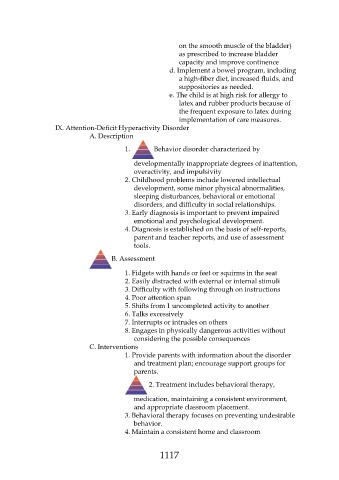Page 1117 - Saunders Comprehensive Review For NCLEX-RN
P. 1117
on the smooth muscle of the bladder)
as prescribed to increase bladder
capacity and improve continence
d. Implement a bowel program, including
a high-fiber diet, increased fluids, and
suppositories as needed.
e. The child is at high risk for allergy to
latex and rubber products because of
the frequent exposure to latex during
implementation of care measures.
IX. Attention-Deficit Hyperactivity Disorder
A. Description
1. Behavior disorder characterized by
developmentally inappropriate degrees of inattention,
overactivity, and impulsivity
2. Childhood problems include lowered intellectual
development, some minor physical abnormalities,
sleeping disturbances, behavioral or emotional
disorders, and difficulty in social relationships.
3. Early diagnosis is important to prevent impaired
emotional and psychological development.
4. Diagnosis is established on the basis of self-reports,
parent and teacher reports, and use of assessment
tools.
B. Assessment
1. Fidgets with hands or feet or squirms in the seat
2. Easily distracted with external or internal stimuli
3. Difficulty with following through on instructions
4. Poor attention span
5. Shifts from 1 uncompleted activity to another
6. Talks excessively
7. Interrupts or intrudes on others
8. Engages in physically dangerous activities without
considering the possible consequences
C. Interventions
1. Provide parents with information about the disorder
and treatment plan; encourage support groups for
parents.
2. Treatment includes behavioral therapy,
medication, maintaining a consistent environment,
and appropriate classroom placement.
3. Behavioral therapy focuses on preventing undesirable
behavior.
4. Maintain a consistent home and classroom
1117

